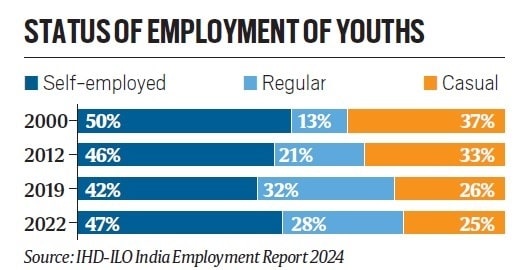The Poor State of Employment in India: Key Findings from the Latest Report

India is having a very serious situation in jobs, especially for youth. However, there are some silver linings that more people are looking for and finding work in larger numbers than ever before. Apart from providing ways to surmount these, the ‘Employment Report 2024’ by the International Labour Organisation (ILO) and the Institute for Human Development (IHD) underscored a few disturbing tendencies and challenges new Indians are facing. The report highlighted that out of work in India, a whopping 83% are the youth, with special focus falling on those who had completed their education but were still without a job. The number of the youth who reach the second but still unemployed level has risen sharply like from 35.2% in the year 2000 to 65.7% in 2022. The situation is further compounded by the fact that there exists a high rate of dropout after completing secondary school. This is a phenomenon that has been observed, especially in less privileged areas and for the many disadvantaged groups.
Of course, many people head to college today more than ever, but that has not necessarily translated into better job prospects, all thanks to the persistent issues still grappling with the quality of education at all levels in the country. The challenge of finding good jobs is made even harder by the slow move away from agricultural work. Much of the younger population either work for themselves or without pay in family businesses. This situation is especially difficult for young women and underscores a bigger problem of gender inequality in work. Another major issue is the quality of jobs open to the youth, with many finding their pay scales to have either stagnated or fallen, particularly among the more educated. This step backward comes at a time when India is trying to make the most of its large young population.

The report stated that to overcome those, proactivity in developing policies is to be made that encourage more productive work outside farming, especially in manufacturing.
But still, there are developments that have greatly been enforced, especially when viewed through the prism of the current COVID-19 pandemic, by the need for small and medium-sized businesses to receive support within a more localized approach, including the use of digital technologies and artificial intelligence, and focus on specific manufacturing sectors. It also speaks of the need to create better quality jobs in care and in digital services, likely to generate more job opportunities for youth. Urbanizing populations; hence, policies that will bring on board the needs of migrants, women, and young people living in poverty.

